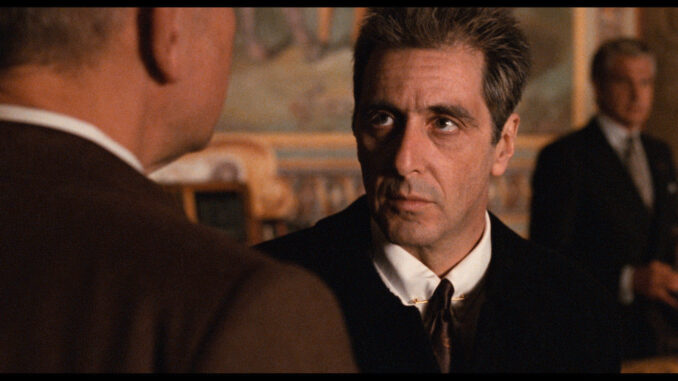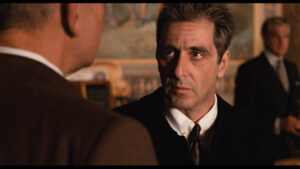
The Problem With ‘The Godfather Part III’ Isn’t Casting, It’s Clarity

The Godfather Part III is a terrible sequel. It has to be. Doesn’t everybody say so? The Sopranos, the Muppets, every other loudmouth film reviewer with a YouTube channel – turn anywhere in pop culture, you can find the third Godfather as the butt of jokes. Whether it’s Al Pacino’s hair, Sofia Coppola’s acting, or Francis Ford Coppola and Mario Puzo’s script, not one element in the film went right. That is, until the re-edited version titled The Godfather Coda: The Death of Michael Corleone came out in 2020 and finally set things to right, making a proper ending for the trilogy.
Or so much of the copy given to Part III has gone. The fact is that The Godfather Part III received mixed-to-positive reviews when it first came out, and it was a contender for many of the major awards at the 1991 Oscars. The fact is, too, that the Coda cut is almost exactly the same as the theatrical release. Other than the opening scene and the last few seconds, there were no substantial changes. Everyone who wrote about how the Coda cut was an eye-opener had their eyes opened to the same movie that’s taken all the cheap shots for the past 32 years.
And here’s another fact: the Coda cut doesn’t fix what’s wrong with Part III — to the extent that anything is seriously wrong with it.
If I seem cross, it’s because I’ve never understood what was so offensive about The Godfather Part III. Coppola and Puzo’s choice to prioritize spiritual concerns over the drug-heavy plots Paramount had toyed with in the years between The Godfather Part II and the third film was inspired. Pacino is excellent as a Michael Corleone that is sheared, haunted, and penitent. The bastard nephew Vincent Mancini (Andy Garcia) is a much more fun and dangerous successor to Michael than a son would have been (another Paramount idea). Connie Corleone’s (Talia Shire) turn toward villainy is riveting, as is Kay’s (Diane Keaton) steely refusal to let Michael off the hook for his past. Carmine Coppola’s music is gorgeous, the costumes and sets are sumptuous, and the extended climax — juxtaposing the opera Cavalleria rusticana with Vincent’s orchestrated hits — is one of the highest highs of the trilogy.
I also can’t understand the appeal of the Coda cut. As already noted, it’s only slightly edited, but the only edits I find an improvement are some color timing. The theatrical cut’s opening on the ruins of the Corleone compound at Lake Tahoe, leading into the ceremony granting Michael a high Catholic honor, paints a better picture of Michael’s state of mind. After that, the only trims made to the Coda cut are seconds’ worth of character interactions and a few scenes with Eli Wallach’s guileful Don Altobello. None of the lost moments was essential, but the character beats helped to illustrate various relationships, and Don Altobello is one of the best things about Part III; cutting his part down did nothing but leech out a bit of devilish charm.
And I’ll even stick my neck out for Sofia Coppola’s work as Mary Corleone. Is her acting rough around the edges? Yes. Mary may be an awkward teenager, but there are times in the film where the awkwardness doesn’t register as authentic, at least not in the way it should for the story. But the weakest spots of the younger Coppola’s performance are the ones involving exposition or relaxed conversation. When she’s called upon to be flirtatious, heartbroken, or a sacrificial lamb for all the sins of her father and family, Sofia delivers.
All this good in the theatrical cut of Part III, and we’re all supposed to point and laugh at it because it’s not quite as brilliant as two of the greatest films ever made? If it’s not The Lord of the Rings: The Return of the King, The Godfather Part III stands above the likes of Return of the Jedi, The Dark Knight Rises, or Indiana Jones and the Last Crusade. Hell, I think it’s been in my Blu-ray player more than the first two Godfathers.
Of course, part of the reason for that is that the first two Godfathers are longer and better; if I’m going to watch them, I want the time to see the whole thing. Part III may be good, but it does have flaws that make it easier to skip to the highlights. Some of the dialogue is weak, so weak that it could almost be from an AI engineered to spew Puzo-esque lines. Other chunks seem contradictory (Michael sold the casinos a while ago…but he’s giving away shares from the selling of the casinos?) There are one or two scenes (none of them Don Altobello’s, and all of them saved for the Coda cut) that don’t do anything for the plot or characters and just seem to exist.
But these are small potatoes. If The Godfather Part III has a near-fatal flaw, as Leonard Maltin once described Sofia’s performance, it isn’t dialogue or padding or casting. It’s in the lack of clarity for the antagonists’ plot.
Ambiguity runs throughout the Godfather trilogy. The first film never shows Don Barzini actively contending with the Corleone Family, nor does it explain the arrangement between Barzini and the Tattaglia Family. The second movie doesn’t elaborate on what information Fredo (John Cazale) gave Hyman Roth (Lee Strasberg) that led to the attempted hit on Michael. In neither case was elaboration necessary. It doesn’t matter what deal Barzini and Tattaglia had; all that matters is that they had one, it brought down Sonny (James Caan), and it therefore expands the Corleone’s scope of vengeance. It also doesn’t matter what Fredo told Roth; what matters is that he betrayed his brother.
The details of the deals and betrayals matter more in Part III. It’s necessary for certain characters to know what’s going on by the third act, and I imagine that the audience is meant to comprehend it too. That isn’t easy to do. The scheme, I think, is this: shadowy forces in the Italian government and organized crime, controlled by Don Lucchesi (Enzo Robutti) have siphoned off millions from the Vatican Bank, with the complicity of Archbishop Gilday (Donald Donnelly). They have also used the international real estate company Immobiliare to launder ill-gotten gains. To cover the theft, Gilday agrees to Michael’s proposed takeover of Immobiliare in exchange for a $600 million deposit in the Vatican Bank. When Michael makes it clear that his intentions are honest, that he will not facilitate money laundering through Immobiliare, Lucchesi uses the accountant Frederick Keinszig (Helmut Berger) to stall the deal, while his American ally Altobello indirectly attempts to have Michael killed.
I say that I think this is the scheme, because it’s never spelled out at once. Individual pieces are explained throughout the film, some of them quite subtly, and some of them with that poor dialogue I mentioned. Piecemeal revelations and trust in an audience’s perception is often to the good, but in this case, characters who need to be aware of developments in this scheme don’t seem to get the information they need, or at least not in a way that clearly registers.
The Coda cut doesn’t fix this. None of the publicly available footage for Part III could. This is a script issue, and one likely tied into production woes. Coppola and Puzo asked for six months to shape their complex plot into a screenplay. Paramount gave them six weeks, obligating the pair to rush out a script and Coppola to frantically rewrite sections during filming. The weakest moments of The Godfather Part III come off as, if not a first draft, then a work in progress. Early drafts of Part II have similar rough patches, but that film had the time — and Coppola had the clout — needed to polish them up. Part III wasn’t so lucky.
But consider this: even as an under-refined screenplay, Part III still has some classic lines to add to the trilogy’s collection of quotes. It has such brilliant scenes as Michael’s diabetic stroke and his confession to the future pope. It has Connie’s moral descent, Vincent’s amalgamation of his forbearers’ best (and worst) traits, an outstanding climax, and a harsh but fitting end for Michael Corleone. No one’s obliged to like a film, but those who seriously contend that The Godfather Part III is one of the most poorly made closers to a trilogy haven’t seen enough of them.
